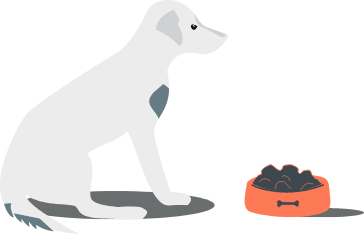
After sterilisation, a dog tends to eat more while its energy needs are reduced by 25% to 30%1.
If your dog eats as and when it wants after sterilisation, its weight can increase by more than 30% after five months1.
Your dog's weight gain is most likely to happen in the two years following sterilisation2.
About 50% of owners feed their dogs without weighing the quantity. .
The health and well-being of your dog relies on maintaining its ideal weight.
1. I. Jeusette, et al. Effect of ovariectomy and ad libitum feeding on body composition, thyroid status, ghreling and leptin plasma concentrations in female dogs. Journal of Animal Phsiology and Animal Nutrition 90 (2006)
2. Yam PS, et al. Impact of canine overweight and obesity on health-related quality of life. Prev Vet Med 2016; 127: 105 -112.
![Group 921.png]() Weight Gain: Man vs Dog
Weight Gain: Man vs Dog
A small dog which puts on 250 g is equivalent to a human of 70 kg putting on 3.5 kg. If the same dog has gained 2 kg of weight, its weight has increased by 40%! At this stage, its obesity is described as "morbid" and it is associated with health problems. This is what happens also when a human of 70 kg in weight reaches 100 kg.
The quantity of dry food given every day must be properly calculated. About 50% of dog owners feed their animals without weighing the quantity given. To keep your sterilised dog at its ideal weight, it is necessary to limit the amount of food it consumes every day. It is not appropriate to give it food every time it wants some! To keep your dog at its ideal weight, respect the ration recommended by your veterinarian.
Measure precisely the ration with a suitable cup or better with kitchen scales to limit the risk of errors. In the long term, a few dozen grams too much of dry food every day weigh heavily in the calorific scale, especially for small dogs.
* Recommended daily ration for a normally active dog fed with VETERINARY HPMⓇ Neutered Dog.

Use a bowl of a suitable size for the amount of its dry food ration. It has been proven that the bigger the bowl, the more owners tend to feed their dog3.
3. Murphy M, et al. Size of food bowl and scoop affects amount of food owners feed their dogs. J Anim Physiol a Anim Nutr 2012; 96: 237-241
To keep the dog at its ideal weight for its whole life, it is, of course, necessary for the whole family to stick to the same codes of conduct as regards the dog. Watch out for children giving their leftovers to the dog!
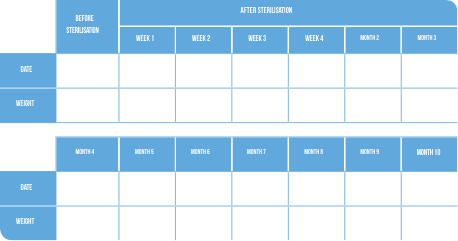
Keep a close eye on any change in your dog's weight after sterilisation: weigh it at least twice a month. It is always easier to correct the situation by reacting as soon as possible.
Weighing must always take place at the same time and on the same set of scales. The scales must be sensitive enough to measure a variation of +/- 100 g for a small dog. Do not hesitate to ask your veterinarian if you can bring your dog regularly to the clinic to be weighed. If you see your dog's weight increasing, even slowly but surely, ask your veterinarian's advice about good diet, in relation to its age, its breed and its lifestyle.
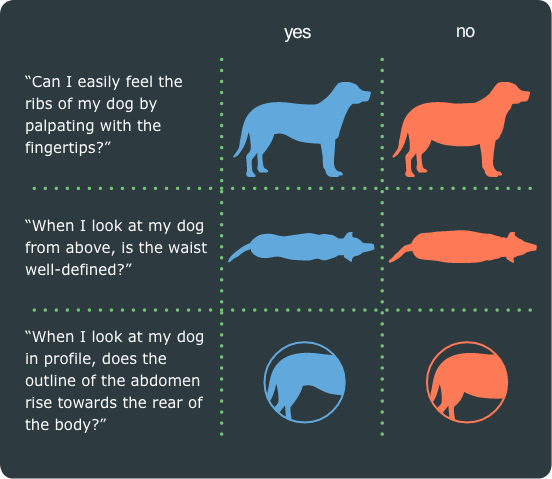

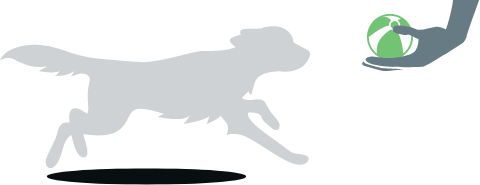
Lack of exercise promotes weight gain. To keep your dog at its ideal weight, it is necessary to encourage it to expend energy every day. The proportion of dogs which live in an apartment which are overweight is higher than that of dogs living outside, but do not think that by simply putting your dog in the garden, it will start exercising!
Take a minimum of 30 minutes of exercise per day with your dog.
The option of simply reducing the ration of your dog's usual food is to be avoided: your dog could feel frustrated at seeing its reduced ration and quickly beg for more food. Furthermore, a significant reduction in the quantity of its usual food can expose the dog to nutritional deficits. It must receive all nutritional components essential to its health in a sufficient quantity.



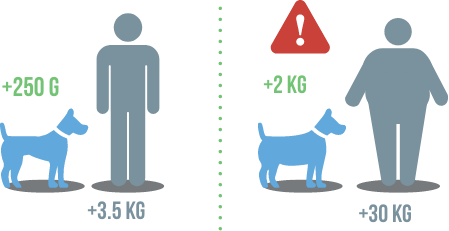 Weight Gain: Man vs Dog
Weight Gain: Man vs Dog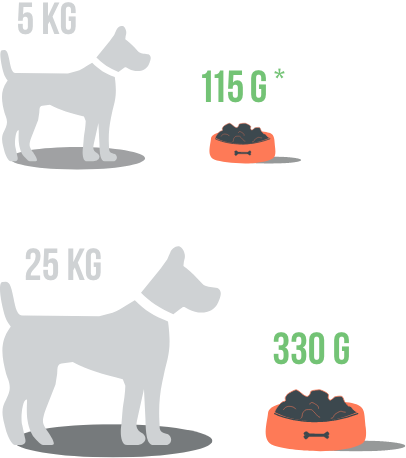
.png)
